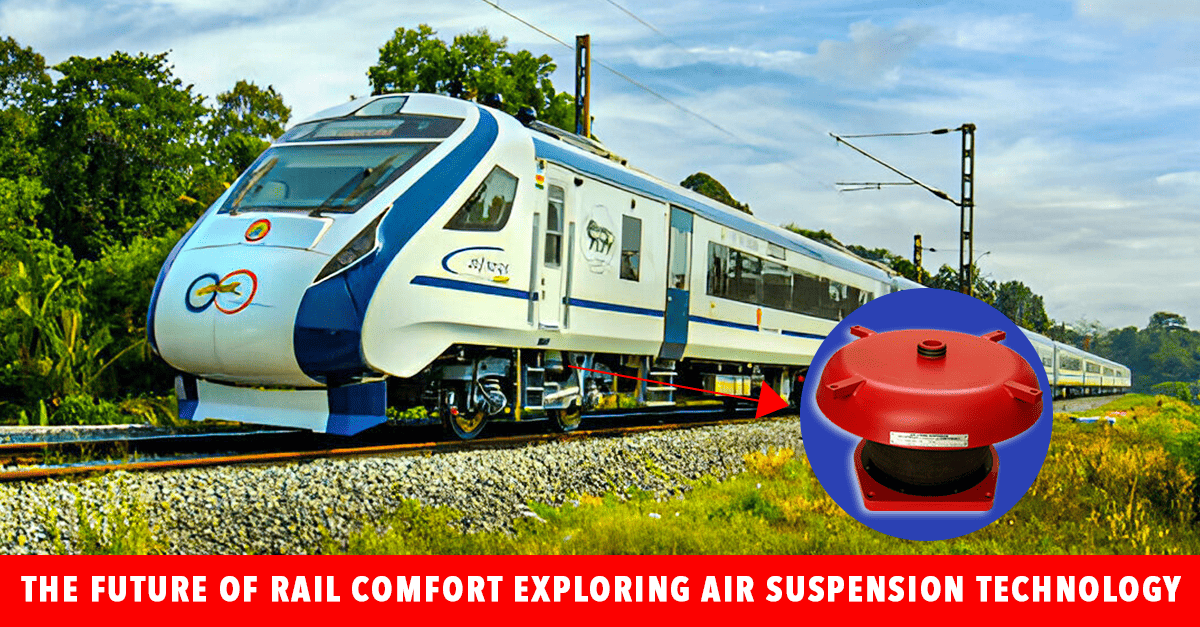The Future of Rail Comfort
- 21 Feb 2025
- The Future of Rail Comfort
The Future of Rail Comfort: Exploring Air Suspension Technology

Introduction
Railways have always fascinated me—the thought of massive trains gliding across vast distances is nothing short of incredible. It’s amazing how tons of metal can move so smoothly, making travel both efficient and economical. One of the key innovations behind this seamless experience with comfort is air suspension.
What is Air Suspension?
An air suspension system replaces traditional helical coil springs with air-filled bellows or airbags. These air springs are designed to absorb shocks and vibrations, providing a more stable, smooth and comfortable ride. Unlike conventional suspension, an air suspension system in railways can adjust its stiffness dynamically, offering optimal performance under different load conditions.
How Does Air Suspension Work in Railways?
The working mechanism of an air suspension system in railways is fascinating. Here’s a simple breakdown:
- Air Compressors: These generate the compressed air needed to inflate the airbags.
- Air Springs: Flexible rubber bellows that expand and contract to absorb shocks.
- Height Sensors: Monitor the train’s position and adjust the air pressure accordingly.
- Control Valves: Regulate airflow to maintain balance and stability.
- Air Reservoir: It holds compressed air for the suspension system, allowing for rapid height change.
This dynamic setup ensures that even at high speeds, the train remains stable, offering passengers a superior travel experience.
Benefits of Air Suspension in Railway Coaches
As someone passionate about engineering and innovation, I can't stress enough how crucial air suspension systems are in modern rail transport. Here’s why:
- Enhanced Ride Comfort:
- Traditional suspensions rely on helical coil springs that transmit vibrations directly to the train coaches. In contrast, an air suspension system absorbs these shocks, making the ride smoother for passengers.
- This technology is particularly beneficial for high-speed trains, where even minor vibrations can cause discomfort.
- Reduced Wear and Tear:
- The air suspension system in railways significantly reduces stress on bogies and tracks.
- With less mechanical strain, maintenance costs drop, extending the lifespan of railway components.
- Load Adaptability:
- One of the key benefits of air suspension is its ability to adjust according to the load.
- Whether a train is fully packed or nearly empty, the system maintains a consistent ride height. This ensures optimal comfort and performance.
- Noise Reduction:
- Ever noticed how some trains are quieter than others? That’s the magic of air suspension systems.
- By minimizing metal-to-metal contact, this system helps reduce noise pollution inside and outside the train.
Air Spring Suspension for High-Speed Trains
High-speed rail networks worldwide rely on air spring suspension to ensure stability and comfort at high velocities. The ability of air suspension systems to adapt dynamically makes them an ideal choice for bullet trains and metros.
Air Suspension vs. Conventional Suspension
- Air Suspension System:
- Provides a smoother, quieter ride: Air suspension systems greatly minimize noise and vibrations, ensuring a much more comfortable and quiet experience for passengers.
- Dynamically adjusts to load variations: The system automatically adapts to changes in load, maintaining consistent performance and stability regardless of weight variations.
- Reduces maintenance costs: With fewer moving parts and less mechanical wear and tear, air suspension systems result in lower maintenance expenses.
- Extends the lifespan of train components: By reducing shocks and vibrations, air suspension systems help protect and prolong the life of critical train components.
- Conventional Suspension:
- Simplicity and Maintenance: Coil springs have a simpler design and are easier to maintain compared to air springs. They don't require complex air supply systems or regular monitoring of air pressure.
- Durability: Coil springs are generally more durable and less prone to damage from debris, external hits, or rough terrain. They can handle higher loads and tougher conditions.
- Cost-Effective: Coil springs are typically more cost-effective both in terms of initial installation and long-term maintenance. They don't require specialized equipment or trained personnel for maintenance.
- Extended Lifespan: Coil springs tend to have a longer lifespan compared to air springs, which can be more susceptible to wear and tear over time.
Role of Air Suspension in Passenger Comfort in Trains
Providing optimum passenger ride index is a top priority in modern rail systems. Air suspension in railways ensures, a significantly smoother ride free from sudden jerks and shocks, even on long journeys.
Air Suspension System in Indian Railways
Indian Railways has been increasingly adopting air suspension systems in its premium coaches, such as Rajdhani and Shatabdi Express. This move enhances the passenger experience while reducing infrastructure maintenance costs.
The Future of Air Suspension in Railways
Air suspension systems are clearing the way for a more efficient and sustainable railway network. As technology advances, we can expect even smarter systems with AI-driven adjustments, further improving safety and comfort.
For HVAC & MEP contractors, facility managers, and industrial equipment manufacturers, understanding air suspension in railways can open up new opportunities in engineering, maintenance, and innovation.


